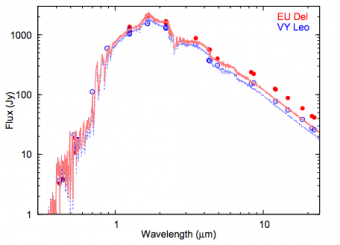 The mechanism that drives the winds of giant stars is poorly determined. Astronomers think there are three possibilities: radiative, in which the pressure of the light pushes out the grains, magnetically driven, in which the stellar magnetic field plays a role in powering the flow, and pulsation driven, in which a periodic build-up of radiative energy in the stellar interior is suddenly released. Over the years scientific opinion has varied among these alternatives, depending on each particular stellar example. CfA astronomer Chris Johnson and his colleagues explored the problem of wind-driving mechanism in giant stars by measuring the motion of the outflowing CO gas around one the nearest and brightest giant stars, EU Del, which is only about 380 light-years away and shines with 1600 solar-luminosities. Its radius, if the star were placed at the position of the Sun, would extend past the orbit of Venus. EU Del is known to be a semi-regular variable star which pulses every sixty days or so (but with some secondary periods as well), and infrared observations suggest it has a circumstellar dust shell.
The mechanism that drives the winds of giant stars is poorly determined. Astronomers think there are three possibilities: radiative, in which the pressure of the light pushes out the grains, magnetically driven, in which the stellar magnetic field plays a role in powering the flow, and pulsation driven, in which a periodic build-up of radiative energy in the stellar interior is suddenly released. Over the years scientific opinion has varied among these alternatives, depending on each particular stellar example. CfA astronomer Chris Johnson and his colleagues explored the problem of wind-driving mechanism in giant stars by measuring the motion of the outflowing CO gas around one the nearest and brightest giant stars, EU Del, which is only about 380 light-years away and shines with 1600 solar-luminosities. Its radius, if the star were placed at the position of the Sun, would extend past the orbit of Venus. EU Del is known to be a semi-regular variable star which pulses every sixty days or so (but with some secondary periods as well), and infrared observations suggest it has a circumstellar dust shell.
See more at: https://www.cfa.harvard.edu/news/su201615#sthash.EqJtI02u.dpuf
Read the pre-print paper at arXiv: http://arxiv.org/pdf/1512.04695v1.pdf

